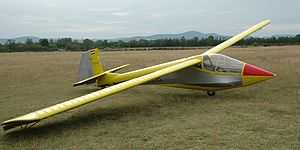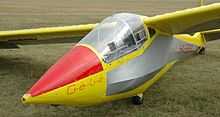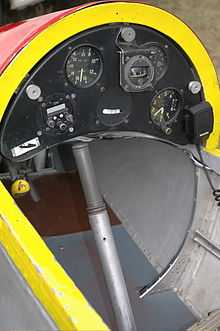Rubik R-26 Góbé
| R-26 Góbé | |
|---|---|
 | |
| R-26SU | |
| Role | Glider |
| National origin | Hungary |
| Manufacturer | Auto-Aero |
| Designer | Ernő Rubik |
| First flight | 6 May 1961 |
| Introduction | 1963 |
| Status | Production completed |
| Number built | 195 |
|
| |



The Rubik R-26 Góbé is a family of Hungarian shoulder-wing, two-seat training gliders that was designed by Ernő Rubik, the father of Ernő Rubik, the inventor of the Rubik's Cube and produced by Auto-Aero.[1][2] After its introduction the R-26 Góbé became the de facto training glider type in Hungary and is still used by many clubs for basic instruction.[3]
Design and development
One of a series of all-metal gliders designed by Rubik from 1957 onwards, the R-26 Góbé was intended to provide two-seat instruction, with the rear seat raised for a view forward.[1][2][4] Series production started in 1962[5] and the first production aircraft flew in August 1963.[3] Almost 200 were produced.[1][2]
The Góbé is of predominately aluminium monocoque construction. The wings have a metal D-box ahead of a single main spar, covered in corrugated metal (this design eliminated the necessity of extra ribs and rivets, thus significantly decreasing production costs and reducing total weight). Aft of the spar they are covered in doped fabric. The wing has a modified a Goettingen 549 airfoil; the Schempp-Hirth air brakes extend from the top and bottom surfaces of the wings and are made of perforated plates for better performance. The slatted Frise ailerons are covered by doped fabric. The landing gear consists of a fixed monowheel and a tail skid. The V-tail of the first prototype was judged unsuitable for training and was replaced on the second prototype and production aircraft by a conventional unit.[4] All the leading edges on the empennage are made of corrugated metal; the control surfaces are covered by doped fabric. The rudder is notably large and effective,[1][2][6] the trim tab is mounted on the right side of the elevator. The control forces are transferred to all of the control surfaces by pushrods, except for the trim tab, which uses bowden cables to attach to the control handle. The instructor seat is not equipped with instruments; the rear seat is raised in order to give the instructor a view on the instruments mounted in front of the student. A separate rear seat instrument kit was available as optional equipment, making the glider capable for instrument (IFR) training.[7]
The R-26S was designed to be easy to disassemble for ground transportation via trailer.[2] It was not certified and the one imported to the United States was registered with the Federal Aviation Administration in the Experimental - Exhibition category.[2][8]
Operational history
In all, 193 production Góbés were built, most serving in Hungary. Fifteen were exported to Cuba, one to the United Kingdom and one to Austria.[3] One R-26S was imported into the US. As of July 2011 it is privately owned and based in Redlands, California.[8] In mid-2010 seventy R-26S and fifty-seven R-26SU remained on the Hungarian civil register.[9]
Variants
- R-26SU Góbé '82
- Modified to meet European/US market requirements. Production begun in 1982, totalling 78.[3]
- R-26M Motor Góbé
- A two-stroke engine was mounted on one of the R-26S models for experimental purposes. The aircraft was later reverted back to R-26S.
Aircraft on display
- R-26S HA-5355 is on display in the Transport Museum of Budapest.[11]
- R-26S HA-5410 is on display in the Museum of Hungarian Aviation, Szolnok.[11]
- R-26S HA-5392 is on display in the Slovak Technical Museum, Košice.[11]
Specifications (R-26S)

Data from Sailplane Directory and Soaring[1][2] The World's Sailplanes:Die Segelflugzeuge der Welt:Les Planeurs du Monde Volume II[12]
General characteristics
- Crew: two, pupil and instructor
- Wingspan: 14.0 m (45 ft 11 in)
- Wing area: 18.000 m2 (193.75 sq ft)
- Aspect ratio: 10.88:1
- Airfoil: Goettingen 549
- Empty weight: 206 kg (454 lb)
- Gross weight: 370 kg (816 lb)
- Max takeoff weight: 400 kg (882 lb)
Performance
- Stall speed: 60 km/h (37 mph; 32 kn)
- Never exceed speed: 170 km/h (106 mph; 92 kn)
- Rough air speed max: 110 km/h (68.4 mph; 59.4 kn)
- Aerotow speed: 110 km/h (68.4 mph; 59.4 kn)
- Winch launch speed: 110 km/h (68.4 mph; 59.4 kn)
- g limits: +2.8 -1 at 170 km/h (105.6 mph; 91.8 kn)
- Maximum glide ratio: 23.7:1 at 81 km/h (50.3 mph; 43.7 kn)
- Rate of sink: 0.96 m/s (189 ft/min) at 75 km/h (46.6 mph; 40.5 kn)
- Wing loading: 20.56 kg/m2 (4.21 lb/sq ft) at normal gross weight, 22.22 kg/m² (4.55 lb/sq ft) at maximum take-off weight
See also
- Aircraft of comparable role, configuration and era
- Related lists
References
Notes
- ↑ 1.0 1.1 1.2 1.3 1.4 Activate Media (2006). "Gobe R-26S Auto-Aero". Retrieved 12 July 2011.
- ↑ 2.0 2.1 2.2 2.3 2.4 2.5 2.6 Said, Bob (November 1983). "1983 Sailplane Directory". Soaring Magazine (Soaring Society of America): 82.
- ↑ 3.0 3.1 3.2 3.3 3.4 3.5 "Hungarian Gliders 1933-2000". Retrieved 13 Oct 2014.
Based on this glider a new dual-control instruction system was developed in Hungary, which is in use even today (2004).
- ↑ 4.0 4.1 4.2 4.3 4.4 Simons, Martin (2006). Sailplanes 1945-1965 (2nd revised ed.). Königswinter: EQIP Werbung & Verlag GmbH. pp. 88–90. ISBN 3 9807977 4 0.
- ↑ 5.0 5.1 Taylor, John W R (1962). Jane's All the World's Aircraft 1962-63. London: Sampson Low, Marston & Co. Ltd. p. 328.
- ↑ Lednicer, David (2010). "The Incomplete Guide to Airfoil Usage". Retrieved 1 July 2011.
- ↑ Jereb Gábor. Magyar vitorlázó repülőgépek (PDF). Műszaki Könyvkiadó. Retrieved 13 Oct 2014.
Az igényesebb repülési feladatok és a műszer szerinti repülés gyakorlásához (ebben az esetben a növendék a hátsó, teljesen befüggönyözhető ülésben ül) az ülések között keresztben húzódó szilárdsági elemre pillanatzárral rögzíthető pótműszerfal illeszthető.
- ↑ 8.0 8.1 Federal Aviation Administration (July 2011). "Make / Model Inquiry Results N510AS". Retrieved 15 July 2011.
- ↑ Partington, Dave (2010). European registers handbook 2010. Air Britain (Historians) Ltd. ISBN 978-0-85130-425-0.
- ↑ Note:Simons places the first flight in 1960 and "Hungarian Gliders" has it exactly a year earlier than the date in Jane's
- ↑ 11.0 11.1 11.2 Ogden, Bob (2009). Aviation Museums and Collections of Mainland Europe. Air Britain (Historians) Ltd. ISBN 978 0 85130 418 2.
- ↑ Shenstone, B.S.; K.G. Wilkinson (1963). The World's Sailplanes:Die Segelflugzeuge der Welt:Les Planeurs du Monde Volume II (in Primarily English with French and German) (1st ed.). Zurich: Organisation Scientifique et Technique Internationale du Vol a Voile (OSTIV) and Schweizer Aero-Revue. pp. 128–129.
Bibliography
- Ogden, Bob (2009). Aviation Museums and Collections of Mainland Europe. Air Britain (Historians) Ltd. ISBN 978 0 85130 418 2.
- "Hungarian Gliders 1933-2000". Retrieved 25 June 2012.
- Taylor, John W R (1962). Jane's All the World's Aircraft 1962-63. London: Sampson Low, Marston & Co. Ltd. p. 328.
- Partington, Dave (2010). European registers handbook 2010. Air Britain (Historians) Ltd. ISBN 978-0-85130-425-0.
- Federal Aviation Administration (July 2011). "Make / Model Inquiry Results N510AS". Retrieved 15 July 2011.
- Lednicer, David (2010). "The Incomplete Guide to Airfoil Usage". Retrieved 1 July 2011.
- Simons, Martin (2006). Sailplanes 1945-1965 (2nd revised ed.). Königswinter: EQIP Werbung & Verlag GmbH. pp. 88–90. ISBN 3 9807977 4 0.
- Said, Bob (November 1983). "1983 Sailplane Directory". Soaring Magazine (Soaring Society of America): 82.
- Shenstone, B.S.; K.G. Wilkinson (1963). The World's Sailplanes:Die Segelflugzeuge der Welt:Les Planeurs du Monde Volume II (in Primarily English with French and German) (1st ed.). Zurich: Organisation Scientifique et Technique Internationale du Vol a Voile (OSTIV) and Schweizer Aero-Revue. pp. 128–129.
- Activate Media (2006). "Gobe R-26S Auto-Aero". Retrieved 12 July 2011.
External links
| Wikimedia Commons has media related to R-26S Góbé. |
| ||||||
| ||||||||||||||||||||||